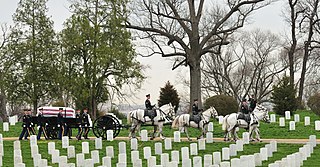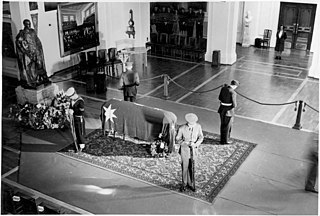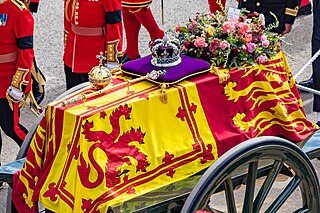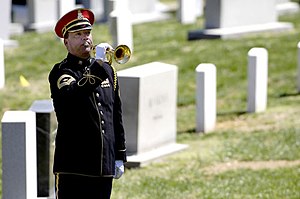
A salute is usually a formal hand gesture or other action used to display respect in military situations. Salutes are primarily associated with the military and law enforcement, but many civilian organizations, such as Girl Guides, Boy Scouts and the Salvation Army use formal salutes. Ordinary civilians also salute informally to greet or acknowledge the presence of another person, such as a tip of the hat or a hand wave to a friend or neighbor.

Anzac Day is a national day of remembrance in Australia, New Zealand and Tonga that broadly commemorates all Australians and New Zealanders "who served and died in all wars, conflicts, and peacekeeping operations" and "the contribution and suffering of all those who have served". Observed on 25 April each year, Anzac Day was originally devised to honour the members of the Australian and New Zealand Army Corps (ANZAC) who served in the Gallipoli campaign, their first engagement in the First World War (1914–1918).

Remembrance Day is a memorial day observed in Commonwealth member states since the end of the First World War to honour armed forces members who have died in the line of duty. The day is also marked by war remembrances in several other non-Commonwealth countries. In most countries, Remembrance Day is observed on 11 November to recall the end of First World War hostilities. Hostilities ended "at the 11th hour of the 11th day of the 11th month" of 1918, in accordance with the armistice signed by representatives of Germany and the Entente between 5:12 and 5:20 that morning. The First World War formally ended with the signing of the Treaty of Versailles on 28 June 1919.

The Returned and Services League of Australia, known as RSL, RSL Australia and RSLA, is an independent support organisation for people who have served or are serving in the Australian Defence Force.

Burial at sea is the disposal of human remains in the ocean, normally from a ship, boat or aircraft. It is regularly performed by navies, and is done by private citizens in many countries.

A military funeral is a memorial or burial rite given by a country's military for a soldier, sailor, marine or airman who died in battle, a veteran, or other prominent military figures or heads of state. A military funeral may feature guards of honor, the firing of volley shots as a salute, drumming and other military elements, with a flag draping over the coffin.

A state funeral is a public funeral ceremony, observing the strict rules of protocol, held to honour people of national significance. State funerals usually include much pomp and ceremony as well as religious overtones and distinctive elements of military tradition. Generally, state funerals are held in order to involve the general public in a national day of mourning after the family of the deceased gives consent. A state funeral will often generate mass publicity from both national and global media outlets.

A riderless horse is a single horse without a rider and with boots reversed in the stirrups, which sometimes accompanies a funeral procession. The horse, sometimes caparisoned in black, follows the caisson carrying the casket. A riderless horse can also be featured in parades to symbolize either fallen soldiers, fallen police officers or deceased equestrian athletes. A motorcycle can be used as a substitute for a horse though such practice is very rare.

On June 5, 2004, Ronald Reagan, the 40th president of the United States, died after having Alzheimer's disease for over a decade. Reagan was the first former U.S. president to die in 10 years since Richard Nixon in 1994. At the age of 93 years, 120 days, Reagan was the longest-lived U.S. president in history at the time of his death, a record which was surpassed by Gerald Ford on November 12, 2006. His seven-day state funeral followed. After Reagan's death, his body was taken from his Bel Air home to the Kingsley and Gates Funeral Home in Santa Monica, California, to prepare the body for burial. On June 7, Reagan's casket was transported by hearse and displayed at the Ronald Reagan Presidential Library in Simi Valley, California, then flown to Washington, D.C., on June 9 for a service, public viewing and tributes at the U.S. Capitol.

The United States Army Military District of Washington (MDW) is one of nineteen major commands of the United States Army. Its headquarters are located at Fort Lesley J. McNair in Washington, D.C. The missions of the units in the Military District of Washington include ceremonial tasks as well as a combat role in the defense of the National Capital Region.

The United States Air Force Honor Guard is the official ceremonial unit of the United States Air Force and is assigned to Joint Base Anacostia-Bolling, Washington D.C.

The three-volley salute is a ceremonial act performed at military funerals and sometimes also police funerals. The custom likely originates with Roman funeral rites. Dirt would be cast on the body three times followed, and the ceremony was ended by the deceased's name being called three times. It was then customary for the friends and relatives of the deceased to repeat the word 'vale' three times. In more recent history three volleys were fired to signify the end of a funeral and that the burial detail was to be ready for battle.

In the United States, state funerals are the official funerary rites conducted by the federal government in the nation's capital, Washington, D.C., that are offered to a sitting or former president, a president-elect, high government officials and other civilians who have rendered distinguished service to the nation. Administered by the Military District of Washington (MDW), a command unit of the Joint Force Headquarters National Capital Region, state funerals are greatly influenced by protocol, steeped in tradition, and rich in history. However, the overall planning as well as the decision to hold a state funeral, is largely determined by a president and their family.

A change of command is a military tradition that represents a formal transfer of authority and responsibility for a unit from one commanding or flag officer to another. The passing of colors, standards, or ensigns from an outgoing commander to an incoming one ensures that the unit and its soldiers is never without official leadership, a continuation of trust, and also signifies an allegiance of soldiers to their unit's commander.

A military funeral in the United States is a memorial or burial rite conducted by the United States Armed Forces for a Soldier, Marine, Sailor, Airman, Guardian or Coast Guardsman who died in battle, a veteran, or other prominent military figures or a president. A military funeral may feature guards of honor, the firing of volley shots as a salute, drumming and other military elements, with a flag draping over the coffin.

The Southport RSL is a sub-branch of Returned and Services League of Australia (RSL) in Southport, Gold Coast in South East Queensland, Australia. Their building is the Southport Bowls Club, located in Marine Parade, Southport. The Southport RSL is a registered not-for-profit charity.

Thai funerals usually follow Buddhist funerary rites, with variations in practice depending on the culture of the region. People of certain religious and ethnic groups also have their own specific practices. Thai Buddhist funerals generally consist of a bathing ceremony shortly after death, daily chanting by Buddhist monks, and a cremation ceremony. Cremation is practised by most peoples throughout the country, with the major exceptions being ethnic Chinese, Muslims and Christians.

On November 30, 2018, George H. W. Bush, the 41st president of the United States, died from vascular Parkinson's syndrome at his home in Houston, Texas. Bush was the first former U.S. president to die in nearly 12 years since Gerald Ford in late 2006. At the age of 94 years, 171 days, Bush was the longest-lived U.S. president in history at the time of his death, a record that was surpassed by Jimmy Carter on March 22, 2019; both were born in the same year (1924).
Sir Raymond Douglas Huish was an Australian returned soldier and ex-servicemen's leader, who served in World War I.

Elizabeth II, Queen of the United Kingdom and the other Commonwealth realms, died on 8 September 2022 at Balmoral Castle in Scotland, at the age of 96. Elizabeth's reign of 70 years and 214 days was the longest of any British monarch. She was succeeded by her eldest son, Charles III.


















